Chemical poisoning and drug poisoning
화학물질 중독과 약물 중독
Overview and prevention of chemical and drug addiction
- In order to prevent drug addiction and household chemical addiction, the United States has established drug and household chemical containers, and child poisoning prevent-proof policies in law to prevent drug addiction and household chemical addiction.
- The incidence rate has been significantly reduced.
- S. pharmaceutical companies and chemical manufacturers have made it difficult for infants, school-age children, adolescents, and even adults to open the lids of drugs or chemicals, especially to prevent household chemical addiction and drug addiction.
- The legislation was enacted. It also makes it difficult to open cheap packaging for drugs or household chemicals.
- Americans seem to be a great country that strives for the health, well-being, and happiness of children and adolescents in this country with a really small effort and money, and to promote the health of the entire United States.
- In the United States, the incidence of child and adolescent poisoning accidents caused by eating and drinking drugs or household chemicals and being buried on the skin has decreased considerably since the legislation was enacted.
- Through education programs or seminars on the prevention of drug and chemical addiction to children and adolescents in the neighborhood or community,
- Through public media education programs such as the Internet, social medicine TV, and radio,
- Through education programs for the prevention of addiction to children and adolescents, drug and chemical substance addiction prevention education programs,
- Through each elementary, middle, and high school student addiction prevention education program,
- Through the school drug and chemical addiction prevention education program, For addiction prevention education for children and adolescents
- Through the drug and chemical poisoning prevention pamphlets published by the Society for Children and Adolescents and the medical community,
- Through a pamphlet for the prevention of drug addiction and chemical addiction, made by pharmaceutical companies and chemical manufacturers,
- The number of accidents of addiction to children and adolescents in the United States has decreased a lot of thanks to the continued education of parental child and adolescent addiction prevention education through other public media.
- However, addiction accidents to children and adolescents with drugs or household chemicals continue to occur for various reasons.
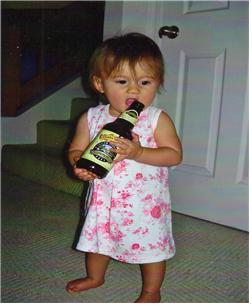
Picture 1-33
Drink drugs, alcohol, chemicals, cleaning chemicals, pesticides, etc. and store them well to prevent poisoning.
Copyright ⓒ 2011 John Sangwon Lee, MD., FAAP
Always be careful not to addict the infants to drugs or chemicals.
Causes of chemical and drug addiction
No matter how well prevented, accidents of chemical or drug addiction can be relatively common among children and adolescents.
In the United States, one million children and adolescents per year are addicted to drugs or chemicals, and about 3,000 die annually, of which 500 are infants and children under the age of five (source; Pediatric Emergencies. Dermer J. Pascoe, MD, and Etc. p.299).
In particular, infants one-year-old or one or two years old toddler children tend to eat and play with whatever they hold in their mouths, and they can’t make good judgments, so drug addiction accidents can occur more easily.
Infants and toddlers are more likely to be addicted to chemicals, drugs, or poisons.
50% of childhood and adolescent chemical poisoning accidents occur in the kitchen,
20% in the bathroom,
10% in the bedroom,
and the rest both inside and outside the home.
Skin burns, dermatitis, and systemic poisoning can occur when chemicals or drugs come into contact with the skin, Chemicals or drugs are aspirated into the airways or ingested orally and absorbed into the body through the gastrointestinal tract, resulting in systemic drug addiction and chemical addiction. Drug addiction accidents may occur in children and adolescents after receiving therapeutic injection drugs by injection or taking oral drugs.
Chemicals or drugs used for suicidal attempts can lead to addiction without death.
Today, some adolescent children take drugs, addictive drugs, or chemicals, causing addiction to them.
These days, even in late school-age children before puberty begins, this kind of addiction accident also occurs. The stress that occurs between parents and children at home, the stress that children and adolescents experience on their own, and children and adolescents who are stressed by parents’ divorce, separation, and bereavement are more likely to develop chemical addiction or drug addiction accidents.
Parents should also be at least the half-doctor-see Encyclopedia of Child and Family Nursing-Volume 2 Prevention of Child and Adolescent Disease Safety Accidents-Prevention of Drug Addiction Accidents.
Chemical substance poisoning prevention, gasoline/kerosene poisoning prevention, pesticide poisoning accident prevention such as pesticides and herbicides, lead poisoning prevention)
Chemicals and drugs that can cause addiction more often
Any kind of drug or chemical can be poison.
Drugs and chemicals that can be more commonly addicted include:
- Drugs such as acetaminophen (brand name-Tylenol, etc.), sleeping pills, iron
- Cosmetics, cleaning chemicals such as soap or soap powder, etc.
- Varnish, wax, petroleum, gasoline, paint, etc.
- Chemicals such as mothballs, rodenticides, pesticides, pesticides, herbicides, fertilizers, etc.
- Chemicals from plastic bowls used as kitchen containers for food or plastic packaging used for food packaging can cause chemical poisoning, and chemical poisoning may occur with chemicals used for washing various dishes.
- Curious infants and toddlers can see drugs and various household chemicals in pretty containers, play with them, drink, eat, and apply them to their skin.
- It can get into your eyes as well.
- So, various chemical poisoning accidents can occur.
- Children and adolescents must be extremely careful not to cause poisoning accidents caused by chemicals, drugs, or poisons. Chemicals and drugs should be kept well, especially in a place out of reach of infants and toddlers.
- If necessary, it should be placed in a safety cabinet and locked with a lock so that no one can open it, especially so that infants and toddlers cannot retrieve it.
- Do not transfer chemicals or drugs from the original container to another container.
- Chemicals or drugs transferred to another container may be mistaken for drugs or chemicals in the current container, and drug addiction may occur due to incorrect use or ingestion of the contents.
- For this reason, do not transfer chemical substances or drugs from the original container to another container.
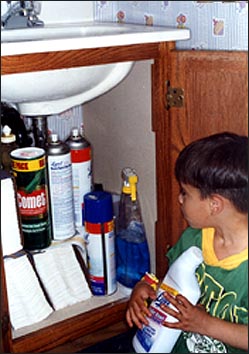
Photo 33.
Make sure to keep household chemicals, drugs, and poisons out of reach of infants. Copyright ⓒ 2011 John Sangwon Lee, MD., FAAP
Treatment of chemical and drug poisoning
- If you suspect that you have sucked, drank, or eaten any chemicals, drugs, or poisons, or if you suspect that they have been sucked into the skin or aspirated into the airways, Substance addiction and drug addiction first aid should be initiated immediately.
- If you are concerned about being addicted to drugs, chemicals or poisons, or because you are concerned about being addicted, seek help from the Poisoning Control Center before taking your child to the hospital emergency room.
- The U.S. Toxic Poisoning Emergency Treatment Center is said to have helped more than 5 million people per year with poison or drug addiction problems (Source: Robert M. Reece, M.D.
- Manual Emergency Pediatrics, 4th Ed. p.205).
- Depending on the situation, parents start the first aid on the spot immediately following the telephone instructions from the medical paramedics, regular pediatrics, and emergency medical centers. If necessary, use an ambulance or other suitable means of transportation to transport the child to a hospital emergency room or poison emergency treatment center, or to an appropriate hospital.
- If you suspect that you have been poisoned by a chemical, drug, or poison before arriving at the hospital emergency room or until your doctor or paramedic arrives at the site, follow the precautions and treatment methods written on the container containing the substance.
- You can do it. However, in the recent American Academy of Pediatrics and Adolescents, the precautions written on containers containing poisons and first aid measures in case of poisoning may sometimes be inappropriate.
- Therefore, precautions for containers containing chemicals, drugs, or poisons. It is recommended to seek the instructions of a doctor before treatment according to the method or treatment method.
- Whether to use an ambulance or other means of transportation to take a child with signs of chemical poisoning or a child who is worried about possible poisoning to the hospital emergency room should be taken according to the situation at that time.
- It is helpful for diagnosis and treatment if you take the chemicals, drugs, or poisons in the container and the instructions in the packaging box, and the chemicals or drugs that remain in the container when you go to the hospital emergency room.
- Depending on the type of chemical, drug, or poison, symptoms of poisoning may or may not appear immediately after sucking, drinking, or eating the chemical, drug, or poison.
- Symptoms of poisoning may appear slowly as it is gradually absorbed into the blood through the skin, respiratory system, or digestive system.
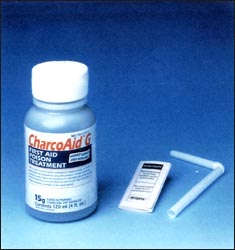
▴ Photo 1-34.
Ipecac syrup (Ipecac syrup) is a drug that can be used for emergency vomiting of poison or drugs swallowed in the stomach after keeping it at home according to the doctor’s prescription.
- For whatever reason, in the past, the American Academy of Pediatrics and Adolescents recommended that emergency treatment by vomiting with Ipecac syrup is allowed to avoid poisoning when excessive intake of chemicals or drugs.
- However, these days, the Academy of Young Children and Adolescents recommends against storing ipecac syrup at home without a doctor’s prescription. Copyright ⓒ 2011 John Sangwon Lee, MD., FAAP
- Robert M. Reece, M.D. Manual Emergency Pediatrics, 4th Ed.
- The Toxidromes information on p.207 can be used as an important resource in determining which drugs or chemicals you are addicted to.
- However, it is difficult to understand for non-medical people. After drinking drugs, chemicals, or poisons, or after they come into contact with the skin or mucous membrane
- Even if no signs of poisoning appear immediately, first aid is initiated at the site or taken directly to the hospital emergency room according to the instructions of a poison treatment center, hospital emergency room, or regular pediatrics department.
- It is common to avoid vomiting emergency treatment when strongly acidic, alkaline, or gasoline, or kerosene is ingested.
- However, there may be exceptions. The principle of treatment is to take first aid to vomit as much as possible and follow the instructions of a doctor before starting treatment for addiction such as drugs or chemicals. When a strong acid, alkaline substance, or almost any drug, poison, or chemical substance, except gasoline or kerosene, is taken orally, vomiting is possible as soon as possible.
- At this time, as much as possible, start first aid according to the doctor’s instructions.
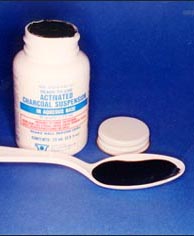
Photo 1-35. The activated charcoal suspension (activated carbon suspension) is used for detoxification because it absorbs harmful substances such as gastric chemicals, poisons, and drugs.
It can be taken orally with a straw and can be injected into the stomach through a nasogastric tube to remove harmful substances from the stomach. Copyright ⓒ 2011 John Sangwon Lee, MD., FAAP
- If you take Ipecac syrup stored at home orally, it is common to vomit the contents of your stomach within 15 minutes.
- However, after consulting a doctor, it is also treated with ipecac syrup (see photo 34).
- If necessary, in the hospital emergency room, an oral or nasogastric tube is inserted into the stomach through the nasal cavity, and poisons, drugs, or chemicals in the stomach are extracted through the oral tube. It may be removed and treated.
- He explained that drugs, poisons, or chemicals in the stomach that have been eaten or drank should be treated in an emergency so as not to be addicted to drugs, poisons, or chemicals in the stomach by making them vomit quickly on site.
- The following will explain more specifically how to treat drugs, poisons, or chemicals by vomiting.
- If possible, call your doctor and follow your doctor’s instructions to treat: Toxic substances such as drugs or chemicals in the stomach can be treated as an activated carbon suspension (activated carbon suspension).
- By feeding the activated carbon suspension with a spoon or straw, you can provide emergency treatment to avoid being addicted to harmful substances in the stomach such as drugs, chemicals, and poisons. Copyright ⓒ 2011 John Sangwon Lee, MD., FAAP
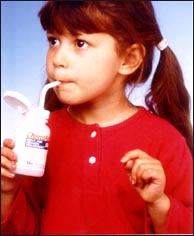
▴ Photo 1-36. Activated carbon suspension can be fed with a spoon or straw to prevent addiction to harmful substances such as drugs, chemicals, and poisons in the stomach. Use with permission Copyright ⓒ 2011 John Sangwon Lee, MD., FAAP
- When you lose consciousness after eating drugs, poisons, or chemicals, and are in a coma,
- When you eat strong acidic substances such as sulfuric acid or strong alkaline substances such as lye, If you drink kerosene or gasoline, you should not treat it by vomiting without a doctor’s instructions. In hospitals, basic life-sustaining cardiopulmonary resuscitation treatment, appropriate antidote, etc. are treated according to the type and amount of drugs, poisons, or chemicals that caused addiction, symptoms, and severity of addiction, and the time elapsed after ingestion.
Chemical Compounds and drugs to be absorbed by Activated Charcoal
See Table 14 Antidote Treatment.
Vomiting can be done with ipecac syrup, or by removing the contents of the stomach with a nasogastric tube or an oral gastric tube.
| 위 내 중독물질 비우는 치료(위세척 치료) 금기Contraindications Ipecac Syrup treatment for Treatment of emptying toxic substances in the stomach (gastric lavage treatment) | 이페칵(Ipecac) 시럽 치료 금기
Contraindications Ipecac Syrup treatment |
활성탄말 치료 금기 Contraindications Activated charcoal treatment |
|
|
|
출처 및 참조문헌 Robert M. Reece, M.D. Manual Emergency Pediatrics, 4th Ed. p.210
By feeding on activated carbon suspensions (parents should also become anti-doctors-Encyclopedia of Pediatrics and Family Nursing)-Vol.21, nursing at home school for children and adolescents-by inhaling harmful substances such as drugs or poisons through a nasogastric tube or an oral gastrointestinal tube.
After extracting, you can prevent and treat toxic substance poisoning by putting activated carbon suspension in your stomach.
When an activated carbon suspension is placed in the stomach, poisoning can be prevented or treated by absorbing harmful substances such as poisons, drugs or chemicals remaining in the gastrointestinal tract in the activated carbon suspension.
See Appendix for drug addiction and chemical addiction treatment.
Drug addiction, chemical substance addiction, or drug addiction treatment is the principle that the doctor is responsible for the treatment appropriately.
Table 16. US Poison Poisoning Prevention and Emergency Treatment Center Starting January 1, 2002, you can get free advice on poison poisoning prevention and emergency treatment across the country by calling 1-800-222-1222 in the United States.
According to the US Consumer Safety and Prevention Committee’s announcement, you can use this phone to get help 24 hours a day, 7 days a week.
After the phone was opened, until recently, 44,000 cases of toxic poisoning-related health problems have been treated as counseling.
I believe that Korean Americans living outside the United States can also use the phone to get help with the prevention and treatment of poisoning.
However, inquiries outside the Americas must pay a phone call fee and can only make calls in English.
In Korea, you can call 00365-1-800-222-1222 (as of July 2010).
The following is an example of an Internet pediatric and adolescent health counseling question and answer about “My baby took a blood pressure medication and had a drug addiction accident”.
Q&A
- My baby took a blood pressure medication and had a drug addiction accident Q. Hello? This is the mother of the baby girl who has passed her stone.
- She found out what my baby spit out three weeks ago, her grandmother took her blood pressure pills out of her bag and put it in her mouth.
- She took out one, and one was broken and on her tongue, so she took it out with her hand and wiped her tongue with a gauze towel.
- She doesn’t seem to have passed it over, so she just stayed without going to the hospital, but the baby hasn’t had any other abnormalities since.
- She was worried that her grandmother then she didn’t go to the hospital, so she’s getting sick now.
- I would like to hear from the doctor.
- Can I rest assured that nothing has happened in three weeks?
- If she ate one or two at that time, what symptoms could appear later? Her grandmother was so worried.
- Please answer me.
- Jung Ah Hello.
- Thanks for asking a good question.
- It is ideal to diagnose and treat the disease by synthesizing the child’s age, gender, past medical history, family medical history, medical examination findings, and clinical examination, but I will provide an answer based on the information provided.
- After 3 weeks of taking the blood pressure medication, most of the blood pressure medication taken is excreted from the body or can no longer be found in the body by metabolism.
- So you can rest assured.
- My grandmother told me to read this article too.
- [Parents should also be at least the half-doctor-Encyclopedia of Child and Family Nursing]-Vol. 2 Prevention of child and adolescent disease safety accidents-Safety accidents, drug addiction accidents.
- Please refer to drug poisoning accidents, etc. In particular, please read the information on poisoning to children’s handbags for women.
- Please consult with the Pediatric and Adolescent clinic after receiving medical examination and treatment.
- If you have more questions, please contact us again, thank you.
- Lee Sang-won., MD
출처 및 참조 문헌
-
Childhood Emergencies in the Office, Hospital and Community, American Academy of Pediatrics
-
Emergency Medical Service for Children, By Ross Lab. May 1989. p.10
-
Emergency care, Harvey grant, and Robert Murray
-
Emergency Care Transportation of Sick and Injured American Academy of Orthopaedic Surgeons
-
Emergency Pediatrics A Guide to Ambulatory Care, Roger M. Barkin, Peter Rosen
-
Immediate care of the acutely ill and injured, Hugh E. Stephenson, Jr
-
The Critically Ill Child, Diagnosis and Management, Edited by Clement A. Smith
-
Emergency Medical Services for Children: The Role of the Primary Care Provider, America Academy of Pediatrics
-
Quick Reference To Pediatric Emergencies, Delmer J. Pascoe, M.D., Moses Grossman, M.D. with 26 contributors
-
Manual of Emergency Care 응급환자관리 정담미디어
-
소아가정간호백과–부모도 반의사가 되어야 한다, 이상원
-
Neonatal Resuscitation American heart Association
-
Neonatology Jeffrey J.Pomerance, C. Joan Richardson
-
Pediatric Resuscitation Pediatric Clinics of North America, Stephen M. Schexnayder, M.D.
-
Pediatric Critical Care, Pediatric Clinics of North America, James P. Orlowski, M.D.
-
Preparation for Birth. Beverly Savage and Dianna Smith
-
Nelson Textbook of Pediatrics 14th ed. Beherman,
-
The Johns Hopkins Hospital, The Harriet Lane Handbook, 18th edition
-
Red book 29th-31st edition 2021
-
Nelson Text Book of Pediatrics 19th-21st Edition
-
Infectious disease of children, Saul Krugman, Samuel L Katz, Ann A. Gershon, Catherine Wilfert
-
The Harriet Lane Handbook 19th Edition
-
소아과학 대한교과서
-
제1권 소아청소년 응급의료 참조문헌과 출처
-
Other
Copyright ⓒ 2015 John Sangwon Lee, MD., FAAP
“부모도 반의사가 되어야 한다”-내용은 여러분들의 의사로부터 얻은 정보와 진료를 대신할 수 없습니다.
“The information contained in this publication should not be used as a substitute for the medical care and advice of your doctor. There may be variations in treatment that your doctor may recommend based on individual facts and circumstances. “Parental education is the best medicine.”